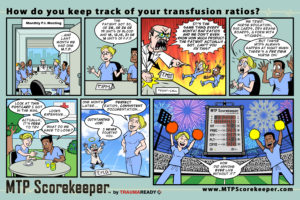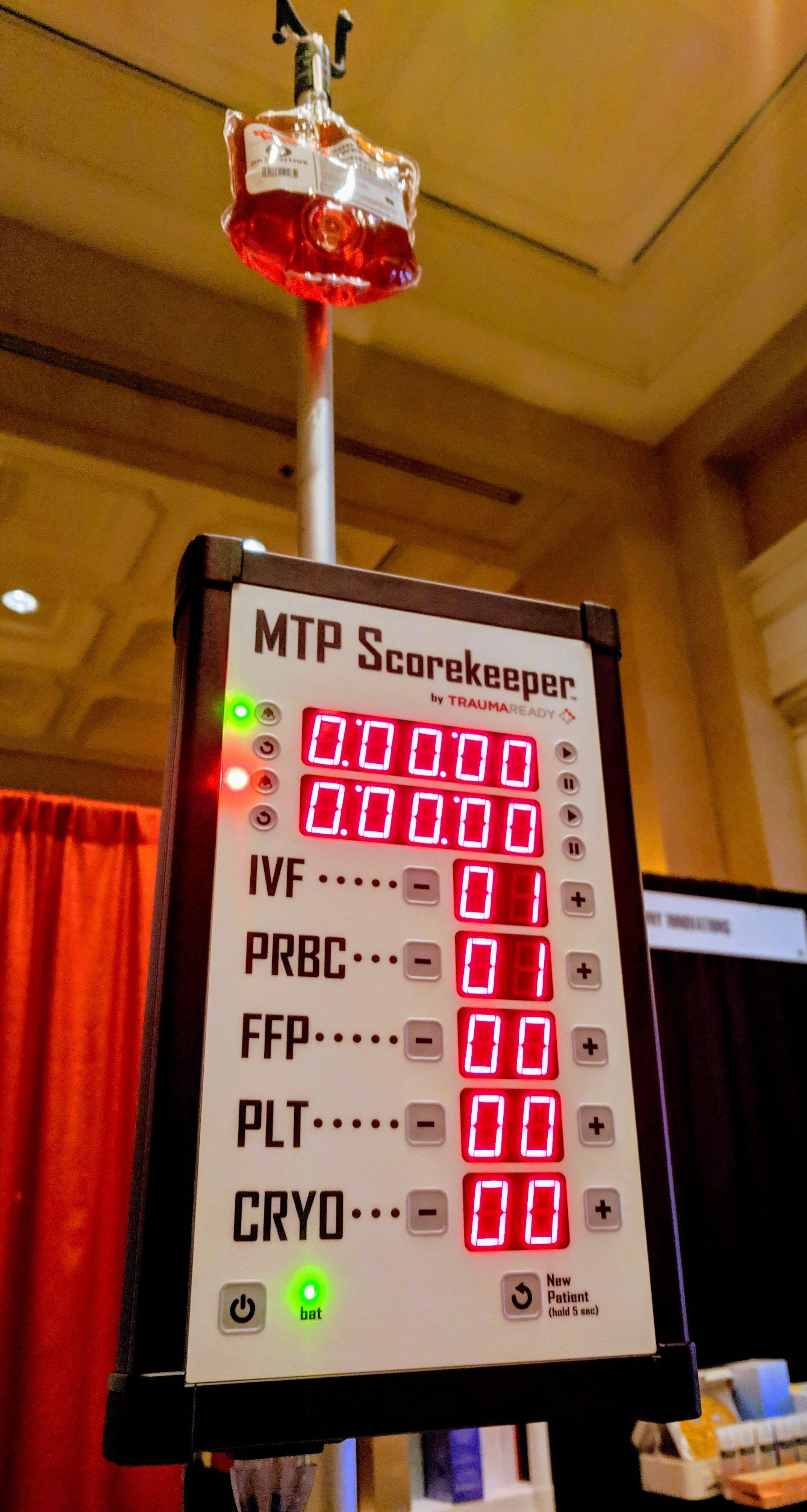Clinical trials have firmly established the relationship between transfusion ratios and survival. But during a fast-paced trauma resuscitation, keeping track of blood components and monitoring crystalloid volumes is a major logistical challenge. A new device called the MTP Scorekeeper™ tracks transfusion ratios and displays them clearly to the entire trauma team.
The MTP Scorekeeper was conceptualized by Alex Guerrero, MD, FACS, a trauma surgeon who has seen trauma teams struggle to develop an effective way to manage massive transfusion protocols. The device was designed by an engineering team at Rowan University.
“We know that getting the transfusion ratios right and limiting crystalloids improves survival in rapidly bleeding patients,” Dr. Guerrero said. “We also know that massive transfusions are a logistical nightmare. They often take place in the middle of the night, they require a lot of coordination with the blood bank, and they occur at the most chaotic time when team members are distracted by other tasks and the team leader is focused on surgically managing hemorrhage.”
“The MTP Scorekeeper helps trauma teams monitor and manage the process better since the transfusion ratios are prominently visible to the entire team,” he said. “The device also features a timer that chimes every 10 minutes. This is designed as a milestone to encourage the trauma team to briefly reassess efforts, avoid task fixation and maintain situational awareness.”
The challenge of tracking transfusion ratios
For the last several years, trauma programs have worked hard to establish effective MTPs. The focus is typically on activating the protocol early; choreographing the movement of blood products from the blood bank to the trauma bay, OR or ICU; and accurately documenting what blood products were administered. But even when the logistics are in place, trauma leaders still face the challenge of monitoring actual transfusion ratios and limiting crystalloid administration in real time.

“As we all know, blood products are available at different times,” Dr. Guerrero said. “Staff often lose track of how many RBC and plasma units were hung, while things like cryoprecipitate might be forgotten altogether. On top of that, you have to take into account any products that were given pre-hospital.”
“You assume that just because there is a massive transfusion protocol at a center, it runs automatically,” he said. “But most of us have been in enough traumas, transfusion committee meetings and M&Ms to know otherwise.”
Trauma teams have tried several ways to keep track of transfusion ratios, but all of them have significant drawbacks.
“Some teams have tried to track ratios on a dry erase board. The problem is that the whiteboard can’t follow the patient if you go to the OR and ICU,” Dr. Guerrero said. “You can try a smaller board, but then it’s too small for everyone to see. It’s the same problem with a sheet of paper that you mark or place stickers on.”
Another option is to track ratios using the EMR. “The issue there is that the information isn’t available to the entire team and the pre-hospital products are not included, so it may not be until the dust has settled that you realize your ratios were sub-optimal,” he said.
To administer massive transfusions effectively, trauma leaders need a system that requires little human management, can travel with a patient and provides critical information to the entire trauma team.
The simple and elegant solution for massive transfusions
The MTP Scorekeeper clearly displays the amount of blood products administered and the volume of crystalloids given. This gives trauma team leaders an easy, intuitive way to keep track of transfusion ratios and helps keep the MTP from going “off the rails,” as Dr. Guerrero puts it.

The MTP Scorekeeper attaches to any rapid infuser. The large, water-resistant display looks like a lighted scoreboard. The device is battery-powered and portable, so it can roll with the rapid infuser to follow the patient from the trauma bay to the OR and the ICU while the resuscitation is ongoing.
“Maintaining 1:1:1 (or a similar pre-defined ratio) while limiting crystalloids is a real challenge when you are in the middle of everything else,” Dr. Guerrero said. “The benefit of the MTP Scorekeeper is that no matter what’s going on, you can look over any time and see what the transfusion ratios are. This way you can keep the MTP on the right course, even when your hands are packing a bad liver injury.”
“We know that a modern transfusion strategy improves patient outcomes,” Dr. Guerrero said. “We also know that hospitals have a difficult time reaching the ideal ratios, and in some cases this results in wasted blood products.” The MTP Scorekeeper has the potential to improve outcomes and help trauma teams give exactly what is recommended by best practices.
“While there isn’t a randomized study that shows the device improves survival, one thing is certain — the MTP Scorekeeper solves the big headache of keeping track of transfusion ratios and limiting crystalloids, which for a surgeon and team leader is worth its weight in gold.”
Now available
The MTP Scorekeeper was officially launched at TraumaCon 2019. According to Dr. Guerrero, the device generated strong interest among conference attendees.
“I get the same feedback over and over,” he said. “Once a trauma team uses the MTP Scorekeeper, they say, How did anyone ever live without it?”
The MTP Scorekeeper is now available for purchase. To learn more, please contact:
Richard Buchler
info@TraumaReady.com
(888) 202-0799

